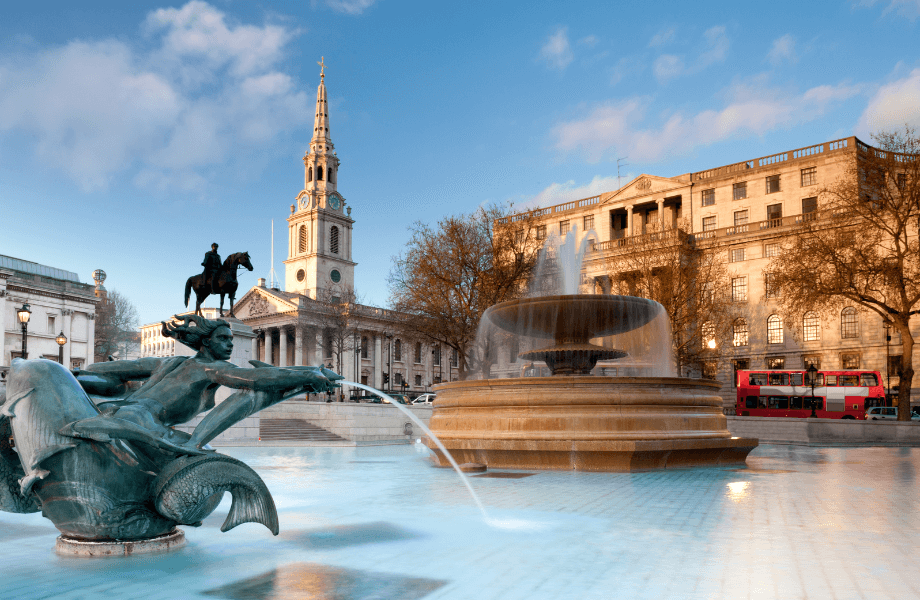London’s largest and most important public square, sweeping Trafalgar Square is a must-stop on any visit to London. Home to world-class museums, imposing monuments, contemporary artworks, an array of street entertainers and much more, Trafalgar Square is one of the most iconic spots in the English Capital. Continue reading to learn more about this stunning square!
Trafalgar Square is named after a sea battle in the Napoleonic Wars
 Trafalgar Square has been one of the most important public spaces in London since it was laid out in the early 19th century. But what’s the origin of its name? The name commemorates the Battle of Trafalgar, a massive maritime battle that took place between the British navy and the combined forces of France and Spain on 21st October 1805, off the coast of Cape Trafalgar near Cadiz in southwestern Spain. The outnumbered Royal Navy, under the command of the charismatic Lord Nelson, scored a decisive victory over the Franco-Spanish alliance and scuppered Napoleon’s hopes of invading Britain.
Trafalgar Square has been one of the most important public spaces in London since it was laid out in the early 19th century. But what’s the origin of its name? The name commemorates the Battle of Trafalgar, a massive maritime battle that took place between the British navy and the combined forces of France and Spain on 21st October 1805, off the coast of Cape Trafalgar near Cadiz in southwestern Spain. The outnumbered Royal Navy, under the command of the charismatic Lord Nelson, scored a decisive victory over the Franco-Spanish alliance and scuppered Napoleon’s hopes of invading Britain.
A column commemorating Lord Nelson stands in the centre of the square

Although the Battle of Trafalgar proved to be a glorious victory for the British, Nelson himself paid the ultimate price, struck down by a French musket shot during the chaotic fighting. Nelson’s body was repatriated to England and given a hero’s burial at St. Paul’s cathedral. To honour the fallen admiral, a 50-metre-tall Corinthian column was erected in the centre of Trafalgar square between 1840 and 1843 to designs by William Railton. The pedestal is decorated with four bronze reliefs depicting various battles in which Nelson was involved during his illustrious career, cast using bronze melted down from captured French cannons. Surmounting the column is a 5.5 metre tall sculpture of Nelson himself, carved from sandstone by the sculptor Edward Hodges Baily. Four lions, meanwhile surround the base, designed by the eminent painter and sculptor Edward Landseer.
Trafalgar Square is the dead centre of London
Trafalgar Square is considered the geographical centre of London, with all distances in the city being measured according to their distance from Charing Cross, located at one corner of the square. The name Charing Cross refers to a memorial cross that was erected here by King Edward 1 in the 1290s to honour his deceased wife, Queen Eleanor I of Castile.
The Fourth Plinth hosts works of contemporary art

Four plinths or pedestals play home to sculptures on either side of the square. Three have been occupied since the 19th century by statues of General Sir Charles James Napier, Major-General Sir Henry Havelock, and King George IV. The fourth plinth, originally intended to play host to an equestrian statue of King William IV that was never made due to a lack of funding, remained empty until 1998, when it was decided to use the space to showcase works of contemporary art. Since then, major works by renowned artists such as Anthony Gormley, Marc Quinn, Rachel Whiteread have all been featured on the plinth. Currently Malawi born artist and academic Samson Kambalu’s depiction of pan-Africanist preacher John Chilembwe stands on the plinth.
Trafalgar Square is home to the National Gallery

Dominating the north end of Trafalgar Square is the imposing bulk of the National Gallery, one of the world’s finest art galleries. Founded in 1824, the gallery is free to enter and plays host to a vast array of spectacular masterpieces from every era of art, from Renaissance stunners by Rahpael, Michelangelo and Titian to Impressionist canvases by Monet, Renoir and many others. To learn more about the magnificent collections of the National Gallery, check out our guide to the Renaissance masterpieces of the National Gallery here.
The famous Trafalgar Square pigeons are no more

For decades Trafalgar Square was famous, or infamous, for the flocks of feral pigeons that descended on the piazza each day. Despite their propensity to damage the square’s monuments the pigeons were a popular tourist attraction, and feeding them was a popular pastime for visitors, with pigeon-feed sellers springing up around the square to cater for demand. To tackle the problem, city bylaws were passed in 2007 that made it illegal to feed the pigeons, on pain of a hefty £500 fine. You’ll still see the odd feathered friend fluttering around Nelson Column, but the vast numbers of pigeons that once inhabited the square are now a thing of the past.
Norway gifts Trafalgar Square a Christmas Tree each December

Each year Trafalgar Square is home to a spectacular Christmas tree with surprising origins. As thanks for British support for the exiled Norwegian government during World War 2, which resided in London during the Nazi occupation of the Scandinavian country, Norway gives the city a massive spruce every December.
Discover the fascinating history and grand monuments of Trafalgar Square on a Best of London tour in the company of a local expert guide. Find out more about this private tour of London here!



